|
Flat-Hatting
| |||||||||||||||||||||||||||||||||||
| Arbitrary deviation from the prescribed mission for the purpose of so-called visits to acquaintances and relatives, involving departure from the prescribed flying height. | |
| Arbitrary low level attacks. | |
| Arbitrary low flying. | |
| Every other type of flying that endangers the aircraft or its occupants arbitrarily. |
Reichsmarshall Goering went ahead to remind his flock that the severest punishment would accrue from Flat-Hatting and called attention to two or three specific cases. One, involving Lieutenant P--, was glaringly similar to the American variety. It had to do with an unauthorized visit to relatives and the inevitable fiancee. P-- flew off his course, landed near his bride-to-be's house, found her absent, and had a couple of beers with his prospective father-in-law. Then he took off, rocked into a black cherry tree and killed a clerk he had taken along as a passenger. Goering himself refused leniency in the case, remarking after the trial, "Flugenkerflatzmittendorfergesellshafftvereingang must stop."

(Lieutenant P-- was imprisoned and sentenced to serve eight years, the time to begin officially at the expiration of the war.)
CADETS sometimes have a tendency to wander out of sight in training planes and practice dog-fighting. Frequently the cadets show great skill in these skirmishes, killing each other just as dead as if they were actually fighting. Such horseplay nearly always results in an accident. The Navy is eager for its flyers to become good dog-fighters but prefers that this sort of practice be done in the approved fashion — under instruction and with PLENTY of altitude.
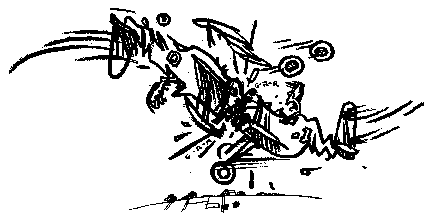
Some low flying is necessary. In the course of your training you may be taken on strafing, masthead bombing and other missions that require very low flying. In these cases, of course, an instructor will be along to show you the correct procedure. This sort of work has nothing to do with Flat-Hatting. It is the unnecessary low flying with which this manual is concerned. There is a lot of difference between making a torpedo run on a Jap carrier and making one on au automobile.
we come to a very painful subject: ALCOHOL 3 It should not be
necessary to remind anyone that flying is a poor chaser for alcohol. Alcohol and gasoline
have never mixed, and never will. Nearly 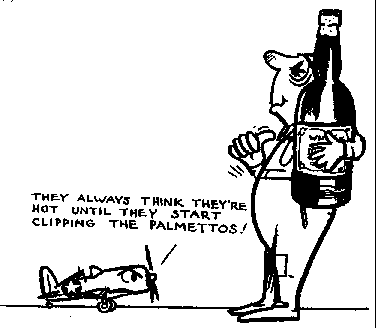 everybody should know this, and perhaps they do, but it is a
sad fact that aviators have been known to step into a plane right after getting out of a
bottle. There is no quicker way to be referred to as "the late" Mr. so-and-so.
Without adopting a tiresome Older Boys Conference tone, we can say in all accuracy that
alcohol, whether in beer, whiskey, martinis, grapa, or canned heat, actually does
dull the brain, slow down the reflexes and induce a dangerous feeling of lassitude and
well-being. Also, and this is most important, it destroys almost completely your sense of
depth perception. When you are flying along comfortably paralyzed and see those two church
steeples coming up, your impulse is no doubt to go between them, but as sure as you do you
will wind up INSIDE the church, as the central figure of a beautiful but rather final
ceremony.
everybody should know this, and perhaps they do, but it is a
sad fact that aviators have been known to step into a plane right after getting out of a
bottle. There is no quicker way to be referred to as "the late" Mr. so-and-so.
Without adopting a tiresome Older Boys Conference tone, we can say in all accuracy that
alcohol, whether in beer, whiskey, martinis, grapa, or canned heat, actually does
dull the brain, slow down the reflexes and induce a dangerous feeling of lassitude and
well-being. Also, and this is most important, it destroys almost completely your sense of
depth perception. When you are flying along comfortably paralyzed and see those two church
steeples coming up, your impulse is no doubt to go between them, but as sure as you do you
will wind up INSIDE the church, as the central figure of a beautiful but rather final
ceremony.
NOT to belabor the subject further, let us concolude this section on the evils of alcohol by the trite admonition: "IF YOU MUST DRINK, DON'T FLY: IF YOU MUST FLY, DON'T DRINK." If you remember this advice and act on it, you have a good chance to become a very old aviator.
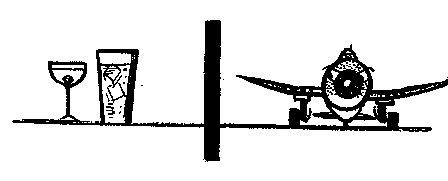
THERE ARE NUMEROUS other foolish ways to fly airplanes, not all of which we can go into here, but a few of the most idiotic should be mentioned. One of the leading contenders is flying aimlessly through clouds. Now it is unhappily true that some pilots fly in a partial cloud most of the time, but oddly enough they never are very successful in combat. About clouds there are two main considerations: (1) Inexperienced pilots should stay out of clouds entirely, because of the danger of colliding with their foolhardy brethren. In a heavy cloudbank the best flyer in the world can't tell what's up ahead. (2) Unless you are an instrument flyer, don't even get into light clouds. If you don't know your instruments thoroughly, you stand a good chance of winding up in a tight spiral or a spin. At low altitude, the effect of these on a plane is approximately the same as that of being hit with anti-aircraft fire.
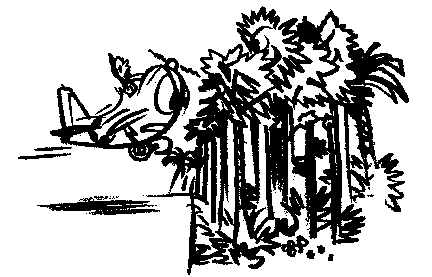
Among the items left on our list, tricky take-offs and landings stand very high. It ishighly recommended by aviators still alive that a pilot take advantage of ALL his runway. Starting from the halfway mark is a wonerfully off-hand and spectacular way to get into the air and will likely impress quite a few people, some of whom may even be interested enough to show up at your funeral But if your engine cuts out in the process of a short take-off you obviously are going to be lacking room in which to come to a safe stop. The big commercial liners, you may observe, not only take advantage of every foot of runway but gun their engines with the brakes on before starting the take-off.
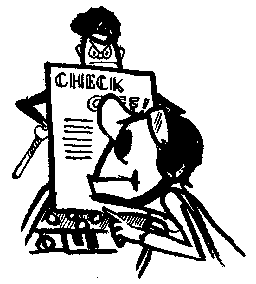
BE SURE to go over your check-off list before getting into the air. Neglecting any one item may result in a bad crack-up. One of the most repulsive kinds of take-off known to modern aviation is the quick zoom, or modified helicopter, variety. Short round trips here are frequent — up a few feet and right back down.
Numerous accidents, for example, are caused by landing with the wheels still up. There is no need to point out that this won't work. It is essential to remember at all times this simple rule:
WHEELS UP AFTER TAKE-OFF — WHEELS DOWN FOR LANDING
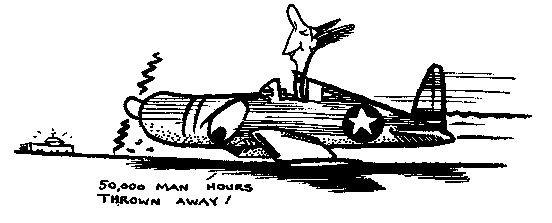
Another point, somewhat akin to the check-off list, is the
correct procedure in shifting fuel tanks. Carelessness in this department has caused an
astonishing number of accidents and fatalities. The following brief case is taken from the
Bureau of Aeronautics News Letter: "This SNJ-3 was over an outlying field
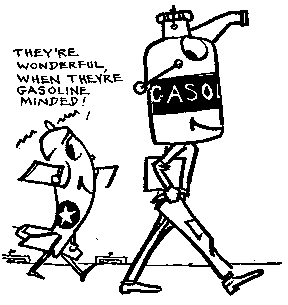 when the engine cut out.
The pilot landed, restarted his engine and took off. Shortly thereafter his engine quit
again and he made a belly landing on the beach. The condition of his airplane after this
landing prevented him from taking off again. The trouble? — Oh, he had merely
neglected to turn his gas selector switch from the left tank, which he had emptied, to the
right one, which was full.
when the engine cut out.
The pilot landed, restarted his engine and took off. Shortly thereafter his engine quit
again and he made a belly landing on the beach. The condition of his airplane after this
landing prevented him from taking off again. The trouble? — Oh, he had merely
neglected to turn his gas selector switch from the left tank, which he had emptied, to the
right one, which was full.
The large number of cases of this kind has led the Bureau to devise the following set of rules governing gas tank switching:
| Never run a gas tank completely dry, unless absolutely necessary. | |
| Never switch tanks at low altitude, if avoidable. If suction is lost, it sometimes requires a little time to regain suction on another tank; don't "short-change" yourself on altitude. | |
| Do not use emergency tank for low altitude flying, particularly practice landings. | |
| If partial failure of fuel system occurs during flight, take the precaution of returning immediately to your base and get the system checked. Don't unnecessarily risk yourself and your airplane. | |
| Get in the habit of checking your gas before descending to low altitude: This check should consist of a visual reference to the gauges and selector valve setting, and a swift mental calculation as to gas consumption and flight time. | |
| When shifting tanks be careful to center selector so that the valve will be properly seated; this can be done by feeling the click. | |
| When an engine sputters, check fuel pressure and selector valve immediately. | |
| Know how much fuel there is in each tank before commencing a flight. Make a mental calculation of how long you can fly on each tank and keep a running check on your fuel gauges and gas consumption. |
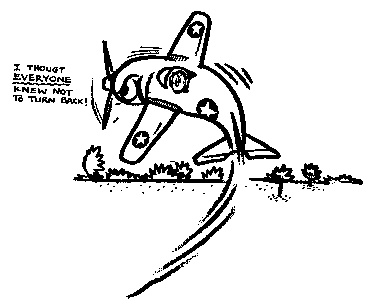 If your engine should cut out at the edge of a field, by all means avoid the
urge to get back on it. It is better to land in somebody's front yard, or even in a
treetop, than to try a 180-degree turn and wind up in a pile.
If your engine should cut out at the edge of a field, by all means avoid the
urge to get back on it. It is better to land in somebody's front yard, or even in a
treetop, than to try a 180-degree turn and wind up in a pile.
DON'T make fake landings; that is, don't dive down to fool
somebody and then zoom up. There is a curious and deadly physical phenomenon commonly
referred to as "the squashing effect" that makes this practice exceedingly
dangerous.
 When
you are heading down and change your controls to level off or climb back up, your plane always
continues farther down before starting back. This often throws your judgment of distance
into error, and you into discard. As a matter of fact, odn't play at diving at the ground
anywhere, over landing fields, beaches, or houses. You will always dive farther than you
had planned and often will land whether you wanted to or not.
When
you are heading down and change your controls to level off or climb back up, your plane always
continues farther down before starting back. This often throws your judgment of distance
into error, and you into discard. As a matter of fact, odn't play at diving at the ground
anywhere, over landing fields, beaches, or houses. You will always dive farther than you
had planned and often will land whether you wanted to or not.
Never get near pylons around which pilots are practicing turns. There have been many accidents involving flyers who, wishing to use the pylons, made a couple of dives on one to show their collleague they were getting impatient. Wait your turn. It's a great deal better for two flyers to do figure eights around pylons consecutively than concurrently.
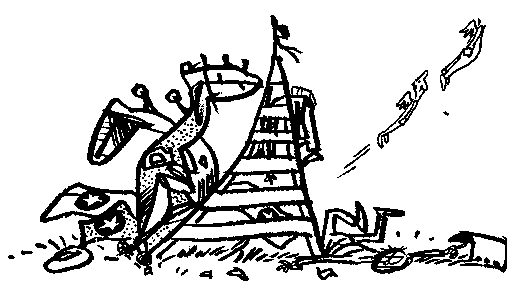
This brings up an especially pernicious practice known as "chasing tails." Started by some anonymous enemy of aviation, chasing tails has laid many a promising flyer to rest. The game, if anything so gruesome can be called a game, is simple. Two pilots chase each other around one or two pylons, the rear man seeing how close he can get to the chasee. To score 4.0 in this game, the rear man obviously must catch the leader, upon which the game is ended, together with the pilots.
A variation of this nuisance is "rat racing," another kind of follow the leader. Often upwards of five or six dunces engage in this sport, rushing pell-mell over the countryside, oding twists, turns, banks, rolls, and dives, each flyer trying to shake off the man behind him. Sometimes as high as 20 percent of the participants return home in one piece.
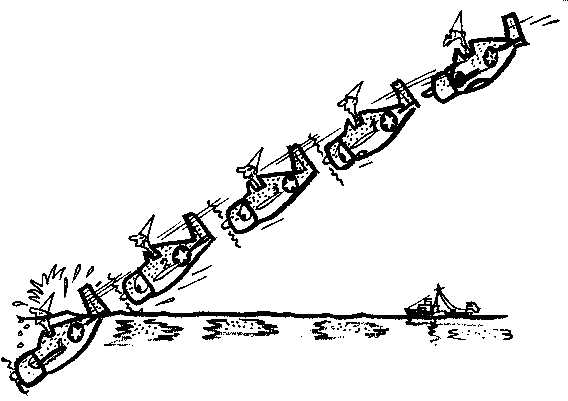
JUST REMEMBER low altitude manuevers are prohibited except when in the syllabus, as skip bombing, strafing, or torpedo run practice.
Again at the risk of being repetitious, act your age; lay off the damned foolishness. It is ABSOLUTELY CERTAIN to bring you to grief.

Despite the rather cheery tone of this document, Flat-Hatting is a very serious business — as can be verified in newspaper reports practically any day in the week. Its consequences are rarely funny. They are more often tragic, and even when there is no injury to personnel, any damage to an airplane in wartime is deplorable. Don't slow up the whole Allied program just because you feel frolicsome. The Axis isn't playing at fighting this war and won't take time out for your to Flat-Hat, so cut it out!
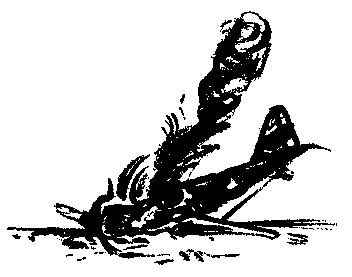
Too, Flat-Hatting sometimes brings other rewards than death, sever injury, and wrecked planes. It was not long ago that two cadets dived down on a field where a farmer's wife was hoeing some plants. Wishing to frighten her into dropping to the ground, the pilot went so low that the plane struck her, decapitating her.
The State authorities prosecuted both cadets on criminal charges. They served terms in prison.
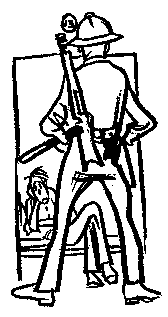
Court martial is a common result of Flat-Hatting, which is, or course, direct disobedience of Navy regulations. Article 15 of the Bureau of Aeronautics Manual reads in part: "The rules restricting the altitudes for acrobatics will be interpreted by Navy pilots to mean that the acrobatic maneuvers must have been completed and normal flight resumed at not less than 1,500 feet altitude." The Manual also prohibits the other kinds of Flat-Hatting we have mentioned. The Bureau holds, further, that the Civil Aeronautics Authority rules on altitude apply equally to Navy pilots.
THESE RULES ARE:
If you like being whole and healthy, and want to see us win the war quickly as possible, fly your plane in an orderly, and sane, manner. If, on the other hand, you don't care about these things, don't Flat-Hat anyhow. Keep an eye on the crack pilots, the boys who are coming back from the wars covered with ribbons. You'll find they don't have time for child's play. Flat-Hatting is one of the big things your instructors bear in mind when they start separating the men from the boys.
SO: If you have to play, buy a Yo-Yo or an electric train. But when you climb into that plane, get down to business.
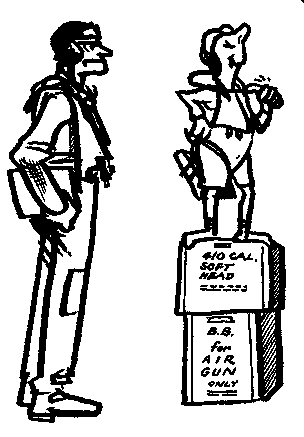
U.S. Government Printing Office: 1944
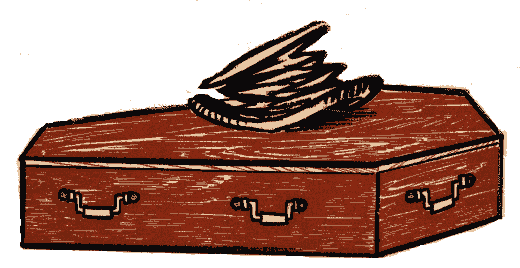
OTHER PUBLICATIONS |
|
| Gunnery Sense Oxygen Sense Prisoner Sense Parachute Sense Dunking Sense Flight Quarters (For CV's) |
Aleutian Sense Arctic Sense Air Information Sense Patrol Sense Don't Kill Your Friends |
| There's No Substitute for Marksmanship Aerology Series |
|
| Ice Formation on Aircraft Thunderstorms The Warm Front The Cold Front |
Fog Air Masses and Fronts The Occluded Fronts The Weather Map |
|
|